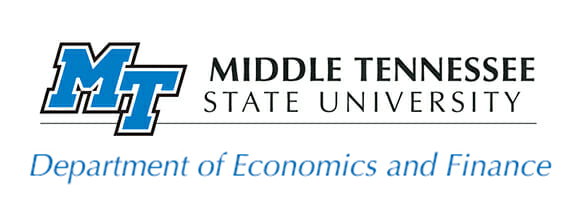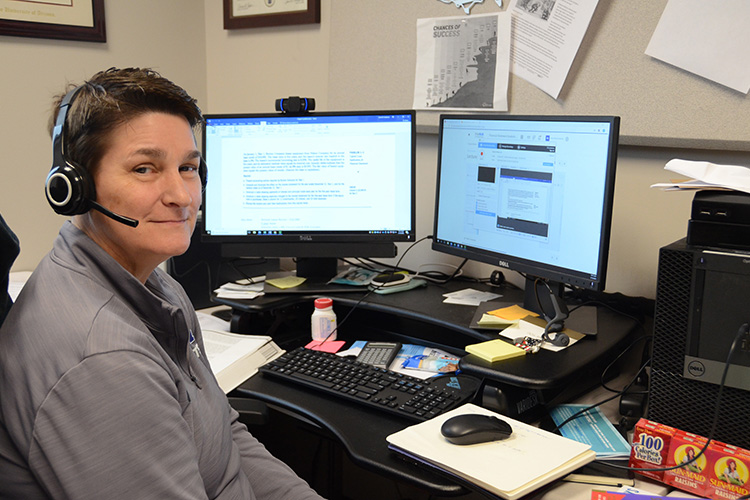For MTSU finance professor Anne Anderson, the university’s switch to remote learning for the remainder of the semester required a significant adjustment to the way she initially envisioned her upper level class.
But it’s one she’s making with a smile, as are hundreds of other professors and instructors across campus in response to the ongoing coronavirus threat. Like other colleges and universities across the state and nation, MTSU has moved to remote learning for the rest of the spring semester.
Anderson, who is also the Weatherford Chair of Finance in the Jones College of Business, has the double challenge of teaching a course remotely for the first time AND teaching this particular course — financial statement analysis — for the very first time as well.

Finance professor Anne Anderson, Weatherford Chair of Finance, tapes a lecture for an online class in the Jones College of Business One Button Studio. (MTSU photo by J. Intintoli)
“This is totally new,” she said recently as Monday’s first day of remote classes loomed. “I’m one of those professors that really likes that conversation in the classroom, and now I’m going, ‘Oh, I don’t get that.’”
But with technical support from the university’s Information Technology Division, Anderson and other faculty and instructors are revamping syllabi while using digital tools like Zoom web conferencing, online discussion boards, PowerPoint presentations and pre-recorded lectures via webcams to adjust to a new academic reality.
Thankfully for Anderson, her new course only has a handful of students, so navigating the communications challenges — like getting students to actually read their emails — are certainly manageable. The lack of in-person interaction will likely lead to static rather than dynamic conversations about course material, she said.
“I’m not going to regurgitate the chapters. I’m going to hit some highlights and give (them) some things to think about,” Anderson said.
Through pre-recorded lectures uploaded to the Desire2Learn (D2L) learning management system, she plans to walk students through the process of arriving at solutions rather than the more interactive in-class dynamic she’d normally use where the instructor can ask students how they would arrive at the solution and have more of an immediate back and forth.
“I’m also trying to figure out the pace of the course in a way when I’m not really feeling pace from the students,” she said. MTSU has a checklist for developing an online course that she can’t really address right now because of the compressed course timeline, so she’ll look to coming semesters to use the checklist to help polish her online course presentation.

MTSU finance professor Anne Anderson, Weatherford Chair of Finance, is shown inside her office in the Business and Aerospace Building. Anderson is using digital tools such as Zoom to teach a remote course on financial statements analysis, the first time she’s taught an online course. (MTSU photo by J. Intintoli)
Students who aren’t used to taking courses online will also need to adjust their levels of self-discipline to stay on track with course work and not fall into the out-of-sight-out-of-mind mentality that leads to missed deadlines, she said.
Anderson’s class is also small enough that she will offer “virtual office hours” during the semester to provide one-on-one feedback and answer questions from her students. And for some students, more hours may be needed as the rest of the semester unfolds.
For example, senior students are getting ready to enter a job market that will likely be drastically different from the one they anticipated just a month ago as the economic fallout from the COVID-19 outbreak continues to unfold. The university’s traditional March career fair was canceled because of coronavirus and prospective employers face a much different set of decisions regarding their workforces.
“I have to recognize the fact that we’re all kind of in this uncharted territory,” Anderson said, noting that the personal situations for each student may be very different in the middle of a global pandemic. “There’s a lot of stressors that everybody’s facing that if you don’t take into account can cause other problems down the road. … Communication is critical.”
— Jimmy Hart (Jimmy.Hart@mtsu.edu)

COMMENTS ARE OFF THIS POST